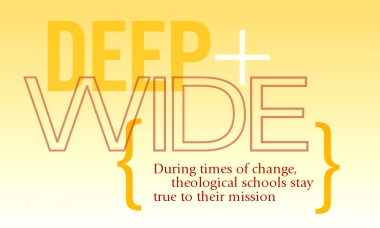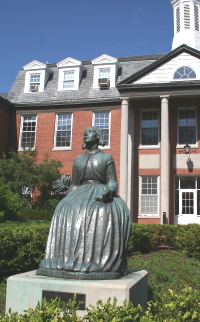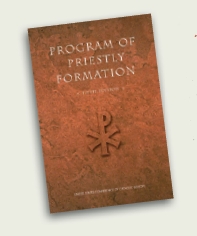
Jay Phelan recalls that when he became president of North Park Theological Seminary in 1996, 85 or 90 percent of the Chicago school's student body were from the Evangelical Covenant Church, the small, historically Swedish denomination that founded the seminary. Today, about two-thirds of the students are Evangelical Covenant.
On the one hand, it's easy to celebrate this in an abstract sense. But it's also important to recognize the sense of loss that inevitably arises as old traditions are subsumed by new. And ethnic traditions aren't the most important factors at stake — a more denominationally diverse student body can signal a greater theological diversity. New students and faculty inevitably introduce new practices and emphases: Perhaps a more charismatic (or, alternately, a more liturgical) spirituality, perhaps less (or more) respect for authority figures, perhaps a zeal for (or staunch resistance to) theological innovations.
So is a changing constituency a problem or a boon? It depends on the seminary's mission. As a student body changes and expands, it is indeed possible to lose what makes a school distinct. And unless the board is careful, it's possible for the board itself to become divided or paralyzed on important issues of identity.
Broader and deeper
Few modern seminaries have the luxury of serving only those people whom their founders intended. Most were established by a single denomination and drew students from a distinct demographic pool who shared a cultural affinity, like Polish Catholic immigrants in Michigan, Scotch-Irish Presbyterians in western Pennsylvania, or Anglicans in francophone Quebec.
But today, many theological schools struggle to keep classrooms filled. And that often means downplaying historical or theological distinctions in order to appeal to a broader, more interdenominational pool of applicants who already live within driving distance. This sort of stretching can precipitate an identity crisis, or it can become a moment of redefining identity. It's all in how the theological school's administration, faculty, and board respond to the challenges posed by such broadening.
With broadening comes the need for deepening. When many different sorts of people fill classrooms — both real and virtual — theological schools cannot serve them in the old ways. Schools need to provide a new richness in the programs they offer and the modes in which learning takes place. Accommodating new constituencies can pose a significant challenge not just to the foundational identity of a school, but also to the quality of education it provides.
For example, seminary courses used to assume that students had at least a beginner's knowledge of worship or liturgical styles, traditional church music, and theology. But no more — in any particular cohort, half the students may be online learners, and the on-campus students may come from 20 denominations and four or five ethnic groups. Faculty cannot make any assumptions about what students already know. And the more different kinds of people are in the room, the harder it is for teachers to teach. Faculty need additional competencies to reach students at their various levels.
One thing is certain, though. For Protestant Christians, denominational ties are proving less important to many of the younger generation. For many, denominational identity is fluid, accidental — sometimes completely unimportant. That means that a great many students are not thoroughly grounded in the traditions and theology of the denomination to which they're officially attached — if they're attached at all.
Denominational tensions
Relationships between seminaries and their founding denominations are not always smooth. One administrator at an evangelical school (not named in this article) recently told me that the seminary has never been well supported by its denomination, but the seminary hasn't made much of its church connection either. With a student body evenly divided between the founding denomination's members and those from other churches, many students are surprised even to know that there is a denominational connection. Moreover, support from the church is only about five percent of the seminary budget.
Yet even at this school, with its relatively weak church ties, denominational leaders have insisted that the school maintain particular doctrinal positions as requirements for employment. Recently, the seminary tried to delete a particular clause in its mandatory faith statement, but influential people close to church and school lobbied the board, which did not feel it could make the change because of this opposition.
Some denominations exercise this kind of control because church leaders recognize that theological education is central to ecclesial life. On the other hand, within other denominations, influential leaders sometimes imply that theological schools are hardly needed at all — that they're old-fashioned, backward-looking, or even irrelevant to the church's mission. And that means that when church coffers are lean, dollars can fail to keep up with inflation.
Declining church support can lead seminaries to chase the golden goose of tuition dollars, either by raising tuition or growing in size. But higher tuition contributes to higher student debt, while growing in size leads to other problems. Jay Phelan of North Park Seminary calls this syndrome "an academic Ponzi scheme," because it's based on a model that requires incessant growth. Phelan recalls the words of environmentalist Edward Abbey, who once said that America's economic philosophy is that of a cancer cell — which eventually kills what it resides in. He fears this may prove true for some seminaries, too. At some point, the school on this trajectory risks becoming too large, losing its focus, and becoming the academic equivalent of a superstore.
How seminaries thrive amid change
Denominational diversity and tensions between schools and denominations are not the end of the story. Ethnic diversity — even age and class diversity - are characteristics of most of the seminaries that have been growing over the last quarter-century. For example, many seminaries have been strengthened and challenged by an influx of Korean, Chinese, and Vietnamese students.
Other seminaries have been reaching out in new ways to African-Americans. For example, Bethel Seminary in Minnesota has a new Community Ministry program aimed at an underserved urban constituency that is mostly African-American. After three years of research and publicity, the program hit a wall — tuition costs were proving prohibitive for potential students. When the administration realized that the salary of the program's director was a fixed cost whether the program flew or not, they made the decision to halve the tuition. And enrollment hit the 40s in that first year.
The issue of mission and distinctiveness came to the fore. What the new program has meant for Bethel, with its reserved Midwestern style, is a significant change in tone. For example, each spring, at a dinner in honor of the community leaders being served by this program, 20 or 30 community leaders are recognized in a parade of accolades — a ceremony of recognition that is familiar to African-Americans but not so much to Scandinavians. Recently retired dean and provost Leland V. Eliason calls this "a total change of ethos."
But while Eliason says that the influence of black students is "one of the biggest blessings" at Bethel in recent memory, he understands that new students and new worship styles can lead to a new identity. "The question is: Are you willing to change the identity of your school?"
Eliason describes a sense of release that can accompany tough changes: Decisions have been made. The board and administration are convinced that new programs will keep the tuition dollars coming while furthering the school's mission. Perhaps it means that the M.Div. is no longer the queen of the seminary's programs, since lay leaders are asking for new sorts of training. Perhaps it means that delivery modes are changing, or that the faces in the seats will soon look very different.
And suddenly, tension is replaced by relief. "We'll enlarge our sense of mission to include this, because it's also a good thing."
 Yet there's a risk. Eliason echoes Phelan's caution about chasing tuition dollars without regard either to a school's historic identity or, just as important, to the shifting needs of the church:
Yet there's a risk. Eliason echoes Phelan's caution about chasing tuition dollars without regard either to a school's historic identity or, just as important, to the shifting needs of the church:
"The biggest danger of theological education in this time of economic pressure is that we'll lose our sense of mission for the changing nature of the church," says Eliason. "The question is whether we will stay on mission or will forget about this and say we have to have programs that get tuition money so we can keep going."
Staying true to the mission while changing to meet the needs of a changing church — that's a tough balancing act for a faculty, for an administration, and especially for a board.
Swedish or diverse? Maybe both
 |
| The entrance of North Park Seminary is marked by a sculpture of Lina Sandell, a 19th-century Swedish hymn writer. |
At North Park Seminary, the path away from its Swedish roots may have been smoother than for some other denominational schools. The heritage of its denomination, the Evangelical Covenant Church, emerged from the European reform movement called "Pietism," and Pietism is inherently irenic, experiential, and ecumenical. Furthermore, it has long emphasized social justice, which is attractive to many non-Covenant students, including many African-Americans.
At the same time, former seminary president Jay Phelan readily admits that not every potential student feels comfortable at North Park. A rigorous Calvinist, he suggests, or someone opposed to the ordination of women, might find the seminary frustrating. But Phelan believes that few students of this sort end up at there, because "students figure out who we are before they get here."
How do Catholic schools stay focused on their mission?
 At Catholic seminaries and schools of theology, cultural diversity isn't a threat to the school's central identity. This is partly because the Program of Priestly Formation serves as the basic structure for theological education and preparation for ministry throughout North America.
At Catholic seminaries and schools of theology, cultural diversity isn't a threat to the school's central identity. This is partly because the Program of Priestly Formation serves as the basic structure for theological education and preparation for ministry throughout North America.
U.S. Catholics have one program, and Canadians have a similar one with the same name. These (and those in other countries) are based on Ratio fundamentalis institutionis sacerdotalis (usually translated as "Spiritual formation in seminaries"), a document from the Vatican Congregation for Catholic Education that lays out the goals of theological education for Catholic priests.
Each seminary adapts the Program of Priestly Formation to its own traditions and strengths. Every five years or so, the program is reviewed to ensure its responsiveness to emerging needs and trends, but the core remains steady. Thus the program provides both clarity and direction to the mission of pastoral formation and leaves schools room to respond to other needs as they emerge.
Questions for boards
-
Measuring change. If our admissions office focuses less on drawing students from our own tradition and more on attracting an interdenominational student body within our region, how will the change affect us? What measurable indicators can help us understand the significance of the change?
-
Denominational formation. Is formation within a particular church tradition part of our school's responsibility? What is the nature of our school's relationship with its affiliated denomination (or diocese or religious order) and supporting congregations? How can we evaluate our effectiveness at forming our students within particular church traditions and polities?
-
Funds and strings. Are we experiencing an imbalance between church support and church control? What is the board's responsibility for addressing this issue?
-
Interdenominational students. In what ways do students from other denominations pose a risk to our church identity? How are formation opportunities and requirements handled for students from other faith traditions?
-
Honesty. Is there truth in advertising in our school's marketing to potential students?
-
Faculty. How does a more interdenominational student body affect the task of teaching in our institution? Is the faculty engaged in discussion about denominational diversity and how it is handled in the classroom, online, and on campus?
-
The board. How does a more interdenominational student body affect the work of the board? Who is accountable for tending our church relationships?